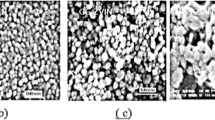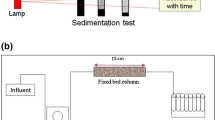Abstract
Widespread use of nanoscale zinc oxide (nZnO) in various fields causes subsurface environment contamination. Even though the transport of dissolved zinc ions in subsurface environments such as soils and sediments has been widely studied, the transport mechanism of nZnO in such environments is poorly understood. In addition, nZnO is often combined with stabilizers or dispersing agents to prevent its aggregation in products. The purpose of this study is to determine the influence of pH on the transport properties of pristine nZnO and carboxymethyl cellulose (CMC) stabilized nZnO (CMC–nZnO) suspensions in silica sand packed column under saturated flow conditions. Transport data were collected at different pHs (pHs: 3, 7, 9, and 11) under 1 mL/min flow rate conditions in a 1.1 cm diameter column. It is found that the transport trends of pristine nZnO and CMC–nZnO were different. For pristine nZnO, mobility of total Zn reached a minimum around its point of zero charge (pH 8.9). Whereas in the case of CMC–nZnO, the mobility of total Zn decreased as the pH of the solution pH increased from 3 to 11. ZnO and Zn ion mixture were separated using diafiltration membrane. It showed that most of the nZnO and CMC–nZnO exists as Zn ion at pH 3 before and after eluting from the sand packed column whereas at pH 11, they exist as particles. This study shows the strong influence of pH and stabilizing agents on nZnO transport. These factors should be considered during subsurface transport of nZnO.









Similar content being viewed by others
Explore related subjects
Discover the latest articles and news from researchers in related subjects, suggested using machine learning.References
Aitken RJ, Chaudhry MQ, Boxall ABA, Hull M (2006) Manufacture and use of nanomaterials: current status in the UK and global trends. Occup Med 56(5):300–306
Becheri A, Durr M, Lo Nostro P, Baglioni P (2008) Synthesis and characterization of zinc oxide nanoparticles: application to textiles as UV-absorbers. J Nanopart Res 10(4):679–689
Brayner R, Ferrari-Iliou R, Brivois N, Djediat S, Benedetti MF, Fievet F (2006) Toxicological impact studies based on Escherichia coli bacteria in ultrafine ZnO nanoparticles colloidal medium. Nano Lett 6(4):866–870
Burrell PC, O’Sullivan C, Song H, Clarke WP, Blackall LL (2004) Identification, detection, and spatial resolution of Clostridium populations responsible for cellulose degradation in a methanogenic landfill leachate bioreactor. Appl Environ Microbiol 70(4):2414–2419
Feng D, van Deventer JSJ (2011) Thiosulphate leaching of gold in the presence of carboxymethyl cellulose (CMC). Miner Eng 24:115–121
Franchi A, O’Melia CR (2003) Effects of natural organic matter and solution chemistry on the deposition and reentrainment of colloids in porous media. Environ Sci Technol 37(6):1122–1129
Franklin NM, Rogers NJ, Apte SC, Batley GE, Gadd GE, Casey PS (2007) Comparative toxicity of nanoparticulate ZnO, bulk ZnO, and ZnCl2 to a freshwater microalga (Pseudokirchneriella subcapitata): the importance of particle solubility. Environ Sci Technol 41(24):8484–8490
Ghosh S, Mashayekhi H, Pan B, Bhowmik P, Xing BS (2008) Colloidal behavior of aluminum oxide nanoparticles as affected by pH and natural organic matter. Langmuir 24(21):12385–12391
Guzman KAD, Finnegan MP, Banfield JF (2006) Influence of surface potential on aggregation and transport of titania nanoparticles. Environ Sci Technol 40(24):7688–7693
He F, Zhao DY (2007) Manipulating the size and dispersibility of zerovalent iron nanoparticles by use of carboxymethyl cellulose stabilizers. Environ Sci Technol 41(17):6216–6221
He F, Zhang M, Qian TW, Zhao DY (2009) Transport of carboxymethyl cellulose stabilized iron nanoparticles in porous media: column experiments and modeling. J Colloid Interface Sci 334(1):96–102
Hu Y, Chen J, Xue X, Li T, Xie Y (2005) Room-temperature irradiation route to synthesize a large-scale single-crystalline ZnO hexangular prism. Inorg Chem 44(21):7280–7282
Jaisi DP, Saleh NB, Blake RE, Elimelech M (2008) Transport of single-walled carbon nanotubes in porous media: filtration mechanisms and reversibility. Environ Sci Technol 42(22):8317–8323
Johari WLW, Diamessis PJ, Lion LW (2010) Mass transfer model of nanoparticle-facilitated contaminant transport in saturated porous media. Water Res 44(4):1028–1037
Joo SH, Al-Abed SR, Luxton T (2009) Influence of carboxymethyl cellulose for the transport of titanium dioxide nanoparticles in clean silica and mineral-coated sands. Environ Sci Technol 43(13):4954–4959
Kanel SR, Nepal D, Manning B, Choi H (2007) Transport of surface-modified iron nanoparticle in porous media and application to arsenic(iii) remediation. J Nanopart Res 9(5):725–735
Kanel SR, Goswami RR, Clement TP, Barnett MO, Zhao D (2008) Two dimensional transport characteristics of surface stabilized zero-valent iron nanoparticles in porous media. Environ Sci Technol 42(3):896–900
Karamalidis AK, Voudrias EA (2009) Leaching and immobilization behavior of Zn and Cr from cement-based stabilization/solidification of ash produced from incineration. Environ Eng Sci 26(1):81–96
Keller AA, Wang HT, Zhou DX, Lenihan HS, Cherr G, Cardinale BJ, Miller R, Ji ZX (2010) Stability and aggregation of metal oxide nanoparticles in natural aqueous matrices. Environ Sci Technol 44(6):1962–1967
Klingshirn C (2007) ZnO: material, physics and applications. ChemPhysChem 8(6):782–803
Kobayashi M, Juillerat F, Galletto P, Bowen P, Borkovec M (2005) Aggregation and charging of colloidal silica particles: effect of particle size. Langmuir 21(13):5761–5769
Kuhnen F, Barmettler K, Bhattacharjee S, Elimelech M, Kretzschmar R (2000) Transport of iron oxide colloids in packed quartz sand media: monolayer and multilayer deposition. J Colloid Interface Sci 231(1):32–41
Lecoanet HF, Bottero JY, Wiesner MR (2004) Laboratory assessment of the mobility of nanomaterials in porous media. Environ Sci Technol 38(19):5164–5169
Li X, He G, Xiao G, Liu H, Wang M (2009) Synthesis and morphology control of ZnO nanostructures in microemulsions. J Colloid Interface Sci 333(2):465–473
Limayem I, Charcosset C, Fessi H (2004) Purification of nanoparticle suspensions by a concentration/diafiltration process. Sep Purif Technol 38(1):1–9
López-Moreno ML, de la Rosa G, Hernández-Viezcas JA, Castillo-Michel H, Botez CE, Peralta-Videa JR, Gardea-Torresdey JL (2010) Evidence of the differential biotransformation and genotoxicity of ZnO and CeO2 nanoparticles on soybean (glycine max) plants. Environ Sci Technol 44(19):7315–7320
Ma HB, Bertsch PM, Glenn TC, Kabengi NJ, Williams PL (2009) Toxicity of manufactured zinc oxide nanoparticles in the nematode caenorhabditis elegans. Environ Toxicol Chem 28(6):1324–1330
Nowack B, Bucheli TD (2007) Occurrence, behavior and effects of nanoparticles in the environment. Environ Pollut 150(1):5–22
Pulikollu RV, Mukhopadhyay SM (2007) Nanoscale coatings for control of interfacial bonds and nanotube growth. Appl Surf Sci 253(17):7342–7352
Rashid MH, Raula M, Bhattacharjee RR, Mandal TK (2009) Low-temperature polymer-assisted synthesis of shape-tunable zinc oxide nanostructures dispersible in both aqueous and non-aqueous media. J Colloid Interface Sci 339(1):249–258
Ryan JN, Elimelech M (1996) Colloid mobilization and transport in groundwater. Colloids Surf A 107:1–56
Scheckel KG, Luxton TP, El Badawy AM, Impellitteri CA, Tolaymat TM (2010) Synchrotron speciation of silver and zinc oxide nanoparticles aged in a kaolin suspension. Environ Sci Technol 44(4):1307–1312
Sedlak A, Janusz W (2008) Specific adsorption of carbonate ions at the zinc oxide/electrolyte solution interface. Physiochem Probl Miner Process 42:57–66
Serpone N, Dondi D, Albini A (2007) Inorganic and organic UV filters: their role and efficacy in sunscreens and suncare products. Inorg Chim Acta 360(3):794–802
Sharma V, Shukla RK, Saxena N, Parmar D, Das M, Dhawan A (2009) DNA damaging potential of zinc oxide nanoparticles in human epidermal cells. Toxicol Lett 185(3):211–218
Stumm W, Morgan JJ (1996) Aquatic chemistry, 3rd edn. Wiley, New York
Sweeney SF, Woehrle GH, Hutchison JE (2006) Rapid purification and size separation of gold nanoparticles via diafiltration. J Am Chem Soc 128(10):3190–3197
Tufenkji N, Elimelech M (2003) Correlation equation for predicting single-collector efficiency in physicochemical filtration in saturated porous media. Environ Sci Technol 38(2):529–536
Warheit DB, Sayes CM, Reed KL (2009) Nanoscale and fine zinc oxide particles: can in vitro assays accurately forecast lung hazards following inhalation exposures? Environ Sci Technol 43(20):7939–7945
Yamabi S, Imai H (2002) Growth conditions for Wurtzite zinc oxide films in aqueous solutions. J Mater Chem 12(12):3773–3778
Yang K, Lin D, Xing B (2009) Interactions of humic acid with nanosized inorganic oxides. Langmuir 25(6):3571–3576
Zhang Y, Chen Y, Westerhoff P, Crittenden J (2009) Impact of natural organic matter and divalent cations on the stability of aqueous nanoparticles. Water Res 43(17):4249–4257
Acknowledgments
This research was funded by and conducted at the National Risk Management Research Laboratory of U.S. Environmental Protection Agency (EPA), Cincinnati, Ohio. This paper has not been subjected to internal policy review of the U.S. EPA. Therefore, the research results do not necessarily reflect the views of the agency or its policy. Mention of trade names and commercial products does not constitute endorsement or recommendation for use. We thank Dr. Raghuraman Venkatapathy for his helpful suggestions. Authors acknowledge Dr. Mallikarjuna Nadagouda for performing XRD analysis, Mr. Phil Cluxton for constructing column experimental setups and gratefully acknowledge the technical assistance efforts of Ms. Catherine Loftspring and Mr. Jim Voit.
Author information
Authors and Affiliations
Corresponding author
Rights and permissions
About this article
Cite this article
Kanel, S.R., Al-Abed, S.R. Influence of pH on the transport of nanoscale zinc oxide in saturated porous media. J Nanopart Res 13, 4035–4047 (2011). https://doi.org/10.1007/s11051-011-0345-8
Received:
Accepted:
Published:
Issue Date:
DOI: https://doi.org/10.1007/s11051-011-0345-8




